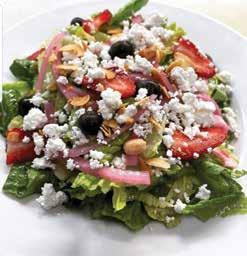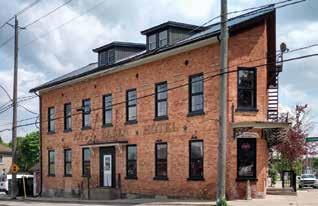
Affordable housing projects, medical buildings and plazas



 165 King Street, Kitchener (former Budd’s Department Store)
165 King Street, Kitchener (former Budd’s Department Store)


they have wonderful artifacts, and no place to properly display them.





 165 King Street, Kitchener (former Budd’s Department Store)
165 King Street, Kitchener (former Budd’s Department Store)


they have wonderful artifacts, and no place to properly display them.
Vol. 7 June 2024
An annual publication of the Wilmot-Tavistock Gazette
Editor: Paul Knowles (pknowles@golden.net)
Advertising: Sharon Leis (sharonbleis@gmail.com)
Graphic Design: Erin Parsons
This publication is made possible through the support of our advertisers.
Contributors: Kristen Hahn, Fred Lichti, Marie Voisin, Paul Knowles
Printed by Ritz Printing
Cover Photos: James Livingston (courtesy Castle Kilbride), Howard and Kim Dolman (Paul Knowles photo), Abhay Patel (Paul Knowles photo).
6. James Livingston, the businessman
The builder of Castle Kilbride also built a successful business empire
By Paul Knowles
9. Growing up in “a special place” Jim Veitch talks about his childhood at Castle Kilbride
By Paul Knowles
14. The Sojourn of an Amish Friendship Quilt
“You know, there’s a story to that quilt.”
By Fred Lichti
17. Those Odd Fellows of Wilmot
Their primary role in the community was to serve as a fraternal benefit order or “friendly society”.
By Kristen Hahn
22. Resilience, determination, survival and success
The story of the Umbach family in New Hamburg
By Marie Voisin
31. Adding thirty years to the history of optometry in New Hamburg
Kim and Howard Dolman continue a long heritage of service
By Paul Knowles
35. Wilmot Heritage Fire Brigades have a superb collection, but little space to show it
“We need larger facilities to display, repair and maintain everything we’ve got.”
By Paul Knowles
37. Ready for the next 150 years
A renovated Baden Hotel celebrates a century and a half
By Paul Knowles

James Livingston is undoubtedly best known as the builder and initial occupant of Castle Kilbride, the well-known national historic site in Baden. And that was undoubtedly a significant accomplishment; Kilbride was without question an architectural showpiece at the time of its construction, in 1877, right up to today as it welcomes visitors from around the world to marvel at the paintings, the décor and the furnishings.
But the truth is, Castle Kilbride is actually a byproduct of Livingston’s real successes – he made his mark as an entrepreneur who created a business empire based in his adopted home town of Baden. If his innovative enterprises had not succeeded, there would be no Castle Kilbride.
Unlike the vast majority of Baden and area residents at the time, who claimed German heritage and language, James Livingston was a Scot, from East Kilbride,
Scotland, now part of Glasgow. He was born on November 27, 1838. In his very early teens, he left school to work in his family’s linen weaving business. And by the time he was only 16, in 1854, Livingston and his brother, John, had immigrated to Canada, arriving virtually penniless but drawn by the stories of unlimited possibilities in the new world. In James’ case, the stories came true.
But not immediately. James initially found work as a farm labourer in Mornington Township in Perth County. He then moved to work in a flax mill owned by M.B. and J.S. Perrine, in Conestogo. The Perrines also owned a flax mill in Baden, and that may be what brought Livingston to this Wilmot township community.
The details may be a bit sketchy, but what is known is that the Livingston brothers turned their hard work into investment in their own business, and those investments paid off. By the mid-1860s, only a decade after arriving in Canada as teenagers, the Livingstons owned a farm near Baden, where they were growing flax. Flax is the raw material for two products very important to the Livingstons’ success – linen, and linseed oil, a key ingredient in paint at the time.
eventually in communities as far afield as Listowel, Toronto, Guelph, Palmerston and Owen Sound. Eventually, the Livingston enterprise reached west into Manitoba, and south into the United States.
By 1871, things were going well for James Livingston, but he would not yet be described as a business magnate. He owned three acres of land in Baden, and a house – but nothing like Castle Kilbride. At the time, he also owned three carriages and sleighs, three horses, two pigs and a cow.
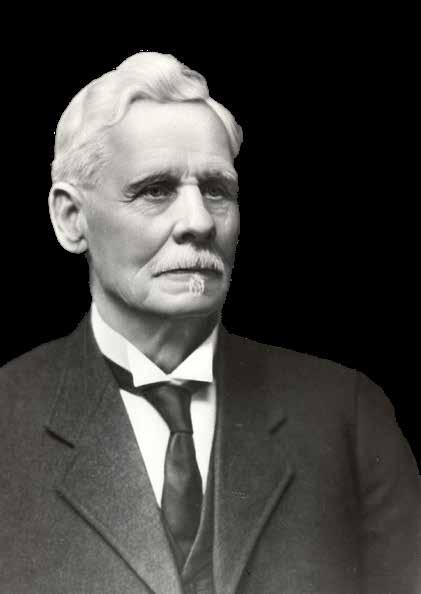
Not interested in providing raw materials to other companies, they began to build their own flax mills, first in Wellesley, then Baden (probably circa 1864 or 1865), and
James Livingston, the Scottish entepreneur who built a business empire, and then Castle Kilbride. (All photos courtesy Castle Kilbride)
One of the two key products of Livingston’s enterprises –linseed oil. The other was linen, both produced from flax seed.
He also owned the mill in Baden, employing 14 men and four boys for nine months of the year. His payroll totaled $2,500. The American Civil War was a boon to the Livingston enterprise. As cotton production crashed in the US, linen became a much sought-after fabric. Business boomed even more when the Livingstons opened a second Baden mill, this time to produce linseed oil. The Livingstons’ Dominion Linseed Oil Company eventually became the largest of its kind in Canada. It’s certainly appropriate that the home of a man so deeply involved in the paint industry is celebrated for its ornate paintings. From the 1870s on, things went from good to great for James Livingston. By 1881, the company was cultivating 3,000 acres of flax each year in Waterloo County, alone. Employment at the Baden mills grew to
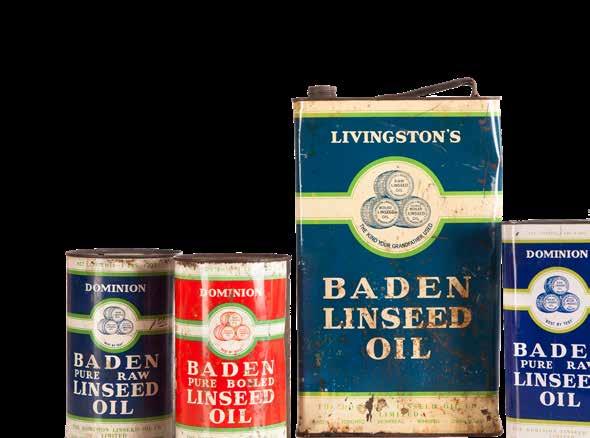

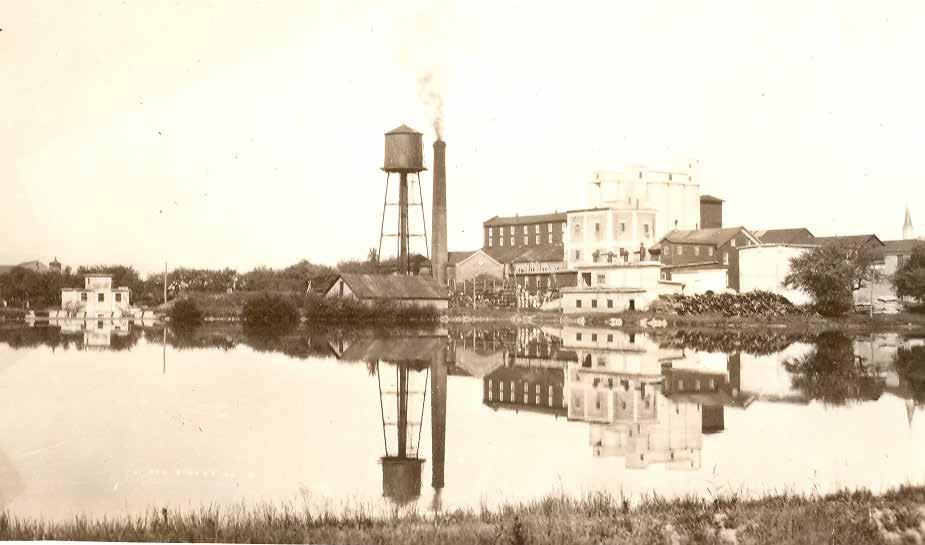
over 200 men. Local women and migrant workers found seasonal work pulling the flax by hand. Scutching mills – which beat the flax to separate the woody fibres from the usable flax – were built on six different local sites. Virtually everyone in the village of Baden was directly or indirectly employed by James Livingston.
It wasn’t until 1876 that Livingston bought Lot 15 North of Snyder’s Road in Baden – a property that had originally been settled by Amish pioneer John Oesch. Within the year, Livingston and his wife, Louise, began to build their dream home, named after his hometown of East Kilbride.
His status as a successful entrepreneur undeniably established, James began taking on more active leadership in his community. In 1878, he was elected Reeve of Wilmot Township, and became a member of Waterloo County Council. He was also elected to the Legislative Assembly of Ontario as an M.L.A. (now more commonly known as an M.P.P.) and he served in the provincial legis-
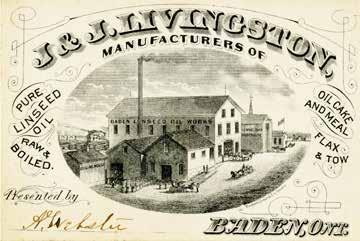


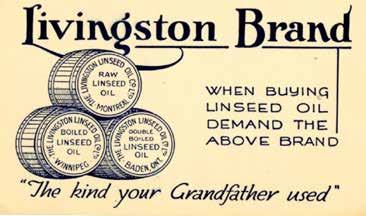
lature from 1879 through 1882. He left provincial politics for the national stage in 1882, and was elected to the federal House of Commons four times, serving as a Liberal M.P. until he retired in 1900.
Long after Livingston’s death, there were published articles stating that Livingston served as a federal cabinet minister, and was appointed to the Canadian Senate just before his demise. Neither story is true. Most of Livingston’s tenure as a M.P. under Liberal leader Wilfrid Laurier occurred when the party was in Opposition, so no Liberal was appointed to cabinet. And there is also no evidence to support the Senate claim.
Although James Livingston retired from his public offices in 1900, his active involvement with his business enterprises continued until his death on April 15, 1920. His obituary described him as “one of the County’s Prominent Citizens… and a shrewd businessman with whom it was always a pleasure to do business.”

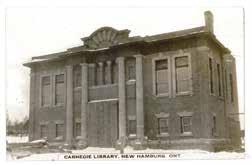

organized as a Mechanics’ Institute housed at the west end of the Imperial Hotel building on East and West, now Huron Street. The library was then funded through paid memberships, government grants and the proceeds from public lectures.
1912: The library eventually replaced the Mechanics’ Institute. The Board of Trade supported the Library Board to obtain a Carnegie Trust grant and on April 30, 1912 funds were received to build a new library building. The population of New Hamburg at that time was 1,485.
1914: The library became an official Public Library under the Public Libraries Act and the library re-located to the south side of what’s now Huron Street. James A. Russel of Stratford designed and oversaw the construction of the Carnegie Library.
1915: The local branch opened in the fall of 1915, and joined the Ontario Library Association.
1968: New Hamburg became part of the Waterloo County Library.
1969: Additional funds were invested in materials, renovations and the adult department opened on Saturday, November 22, 1969. Deputy Reeve Glen McLean acted as the master of ceremonies.
1973: The Regional Municipality of Waterloo was created in 1973, and the Waterloo County Library became the Waterloo Regional Library.
1995: Renovations continued, including an expansion of approximately 1000 sq. ft. of usable space into what were once Wilmot Township offices. The addition is linked to the original Carnegie library by a corridor, showcasing the building’s keystone entrance and brickwork.
2015: The New Hamburg Library celebrated 100 years of the library building, and continues to be a landmark of public architecture and a place of learning, discovery and enjoyment for the community today.




June 18, 1988, was a sad day for Jim Veitch. Because on that day, he was on hand to watch virtually all the contents of his four-generation family home go on the auction block.
And this, by the way, was no typical family home. This was Castle Kilbride, the iconic centerpiece of the village of Baden, built in grand style in 1877 by Jim’s great-grandfather, James Livingston, the man whose name was bestowed on Jim.
Jim’s parents, Harris “Hap” and Laura Louise Veitch, had reached the point where they could no longer take care of the home. The house had already been sold to a developer – “Mom and Dad couldn’t handle it any more.” Now, it was time for four days of selling, as the remarkable contents of Castle Kilbride were up for sale.
Jim had long since moved away from his childhood home. But he had lived at Kilbride from age five to age 23, and he admits it was tough to see it – and its contents – sold off. He was afraid this was the end of an era for Castle Kilbride.
But he had come to the auction with a purpose. There was an item up for sale –a wooden bowl – that he thought should never been offered for sale at all. It was one of his mother’s favourite possessions, a unique, hand-carved wooden nut bowl, and Jim was determined to buy it as a gift for his Mom.
He told me that his father, a collector and antique dealer in his own right, had purchased the bowl from a Port Elgin wood carver, who had produced the burled maple masterpiece by carving it with a broken coke bottle. “My mother loved that bowl. I was bidding to buy it for her.”
The bidding went well above his expectations, but in the end, Jim prevailed – only to later learn that his competing bidder was assigned by Jim’s father to buy the bowl
Jim Veitch with the expensive gift he bought for his mother. (Paul Knowles photo)
for the same reason. Today, he laughs –and points to the nut bowl prominently on display in the foyer of his Foxboro Green home.
Jim’s mother, Laura Louise, only got to enjoy her son’s expensive re-purchase for a few months; she passed away on September 8, 1988. Hap Veitch died in 2006, at age 87.
Laura Louise was the much doted-on granddaughter of James and Louise Livingston, who built Castle Kilbride. Her parents were James’ son, J.P. and his wife Laura (Holwell), who inherited the mansion from James and Louise. Laura Louise was their only child and heir; Laura Louise and Hap Veitch had three children – Jim,
Barbara and Sherry.
Jim was about five when his grandfather J.P. died, ten years after J.P.’s wife, Laura’s death; that’s when the Veitch family moved in to Kilbride, Jim’s home for almost two decades.
He says that while in one sense, it was just his family home, in another, he was always aware it was “a special place… oh, yes.”
He admits that this did not prevent him from doing typically foolish childhood things, like climbing out the window of the belvedere high atop the Castle, to scurry across the roof to recover a tennis ball that had been lofted into the eavestrough.
Jim’s bedroom was on the right, at the top of the grand staircase. He says that “I

believe it was my mother’s bedroom as a child.”
When the original plans to save Kilbride were proposed by Wilmot township Mayor Lynn Myers and a group of community volunteers (including this author), that section of the house was designated to be township offices. But then it was revealed that wallpaper actually covered murals in those rear rooms, too, and the plan was changed, to save all of the Castle (except the kitchen) as a historic site. I asked Jim if he had been aware that his room had hidden paintings. He smiled, “Oh, yes.” He knew that every room had originally been decorated in this style.
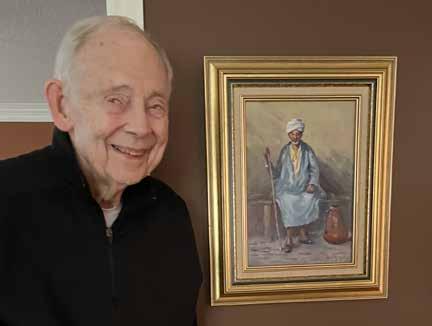
when the creaking of the building caused a few shivers up and down his spine.
Jim says his mother, the much-loved granddaughter of James Livingston, was “an entirely nice person. She was very refined, but didn’t have that condescending way about her. She would welcome anyone.”
Jim’s house today has a few items from Kilbride, including a small painting of a man in what appears to be a Mediterranean setting. Jim explains that his mother brought the painting back from a world tour she, at age 19, and her mother took in the mid-1930’s. He treasures the painting.
Living in Kilbride had its ramifications, he says. Many of his schoolyard friends treated him as an equal, but a few were “stand-offish,” because of the perceived status afforded by living at Kilbride.
He remembers one occasion when a classmate, asked to complete a phrase, amended “as rich as” with “the Veitches,” to Jim’s great embarrassment.
The irony is that by the time that statement was made, it probably was no longer the case. The Livingston success was founded on flax products –linen and linseed oil, used in paint – and by the mid20th century, neither was greatly in demand.
Jim recalls that his parents at times struggled to simply keep the house going. “It was very expensive to maintain,” he says. “I remember, I was 16 years old, when my father told me that it cost $1500 a month to heat the house.”
Adjusted for inflation, that totals almost $15,000 –yes, add a zero – a month for heat.
Like most old mansions, Kilbride comes with some ghost stories. Jim admits he doesn’t buy them. “I grew up not believing in ghosts. I heard the stories, but I never encountered anything supernatural.” He does add, though, that there were times he was alone at night in the house
Castle Kilbride, Jim Veitch’s home for almost two decades. (Copyright Castle Kilbride)
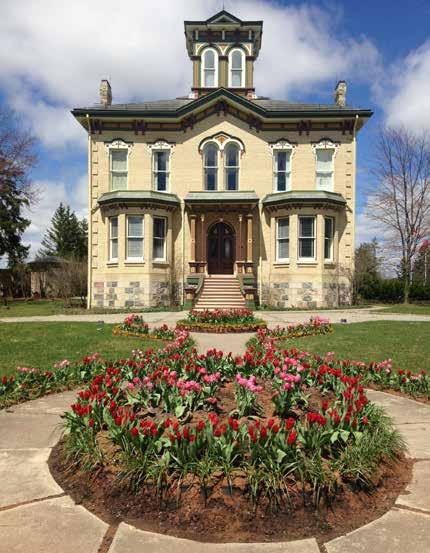
And he tells a story arising from that trip which he admits may be apocryphal – although he would like to believe it. According to the anecdote, Laura Louise and Laura attended the 1936 Olympics in Germany, and were seated not too far from Hitler, himself. When Hitler entered, the crowd arose and gave the Nazi salute, but Laura Louise remained seated in protest, while her mother came close to panic at the potential outcome of such an action. Jim acknowledges that it is of course impossible to prove or disprove the story. But he smiles fondly as he shares it.
Five years after Castle Kilbride and its contents were sold, Wilmot township took the bold move of buying it from the developer-owner, determined to save an important building that was soon designated a National Historic Site. Mayor Myers recruited everyone he could find to volunteer in the cause, funds were raised, and the historic home was saved, restored, and opened to the public, which continues to this day.
Jim was not involved in those early days of saving Castle Kilbride. But he says, “I thought it was a great idea. I could see the place going toward ruin, and it was tough to live with that.”
A few years later, in the late 1990’s, Jim got more involved in the historic
Jim with the painting Laura Louise brought home from her world tour, circa 1936. (Paul Knowles photo)

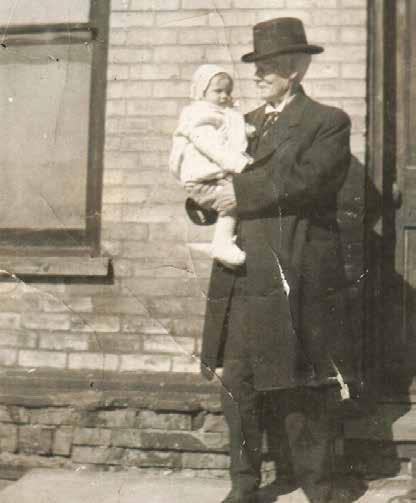



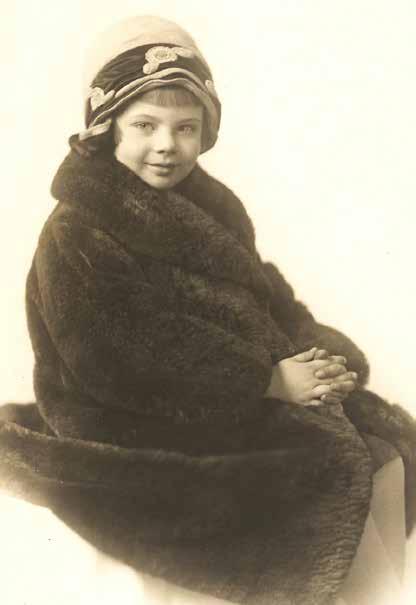



Jim Veitch’s mother, Laura Louise, in one of the fur coats she had in those heady days of her youth. (Copyright Castle Kilbride)
A formal portrait of Laura and Laura Louise. (Copyright Castle Kilbride)




site where he had once tossed tennis balls onto the roof. He joined the board of Castle Kilbride, and stayed involved until quite recently. He commends the volunteers, the staff and the members of Wilmot Council who saved the place, and have continued to operate it.

Locatedintheheartof NewHamburg,ourbusinessoffers atruefamilyrestaurantexperience, withitsrelaxedcountryatmosphere andtraditionalhomecookedmenu.
Locatedintheheartof NewHamburg,ourbusinessoffers atruefamilyrestaurantexperience, withitsrelaxedcountryatmosphere andtraditionalhomecookedmenu.
NewlyRenovated
NewlyRenovated
105PeelSt.,NewHamburg
Asked about his personal view of the future of Castle Kilbride, Jim says, “I hope they can maintain it, that funding keeps on coming. I hope that they’re able to promote it, to educate people.”
105PeelSt.,NewHamburg 519.662.4545
And he would love to see one element of that education be focused on his grandfather, J.P., who was also known as Jack. Much of the information available about Kilbride concerns James Livingston, and understandably so – James was the founder. But his great-grandson and namesake encourages people to remember that J.P. was also noted for his “business acumen.”
519.662.4545


p g , , plane carrying 17 Wilmot Township council members and their spouses, a couple of other civic leaders, and two representatives of the local newspaper, landed in Paris and were loaded onto a bus for the cross-country journey to Alsace.
And so it came to pass… on August 3, 1991, a plane carrying 17 Wilmot Township council members and their spouses, a couple of other civic leaders, and two representatives of the local newspaper, landed in Paris and were loaded onto a bus for the cross-country journey to Alsace
And here is where my story will become more personal
And here is where my story will become more personal
In short, Jim says, “I hope they can continue to do their good work.”
It wasn’t long after our arrival in Alsace that it became clear we were to be treated like royalty, showered with gifts, feted at banquets and special events, and presented to civic leaders at
It wasn’t long after our arrival in Alsace that it became clear we were to be treated like royalty, showered with gifts, feted at banquets and special events, and presented to civic leaders at


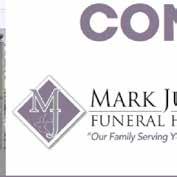


When you stroll through a local antique shop, do you ever imagine discovering some long, lost family heirloom? What a delightful surprise it would be to find an old wooden plane stamped with your great grandfather’s name. Or, how about an old sampler, hand stitched and signed by your maternal ancestor? Though I haven’t found any antiques from my family’s past, I did play a role in helping my friend’s family recover a precious heirloom.
Some years ago a collector of fine antiques held an auction sale at a hall in Waterloo Region. For decades he had frequented estate auctions in the area, purchasing only the best antique pottery, furniture and fabric arts. At the Friday evening viewing I milled around the large hall with hundreds of antique dealers, casual collectors and curiosity seekers. We were all there to view the extravaganza of items that would be offered at auction the following day. There were pieces of pottery, hooked rugs, Jacquard coverlets, old German books with beautiful fraktur lettering and lots of furniture with original paint. But it was the “friendship quilt” that stopped me in my tracks. All the colourful patches included a familiar surname from the local Amish Mennonite community---Jantzi, Erb, Nafziger, Gerber and others with a distinct local connection.
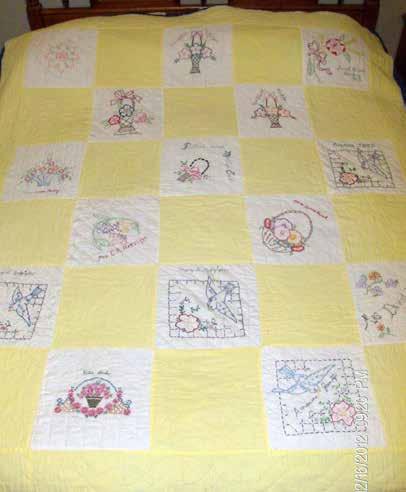
The 15 names on Emma’s quilt and their relationship to her from top, left to right: Ruth Nafziger seven years - niece, Mrs. Sam Nafziger - Emma, Sarah Kennel, Bamberg, Ont.- friend, Emma Gerber - niece, Mrs. David Nafziger - cousin, Mrs. Jonas Jantzi - cousin, Father and Mother Erb - parents, Mrs. Nic Jantzi -neighbour, Mrs. E. R. Nafziger - sister, Mrs. Amos Brunk - friend, Mary S. Nafziger - sister-in-law, Mary E. Nafziger - daughter, Mrs. David Roes - cousin, Katie Gerber - niece, Amanda Jantzi - neighbour.
Who were these women? When and where did this quilt originate? How did it become part of this collection? As I pondered these questions, a voice from behind interrupted my musings. “You know, there’s a story to that quilt,” said the voice. Turning around, I recognized the antique collector himself. “Oh, really?” I replied. “I’d be glad to hear it.”
The collector said, “About 25 years ago I read in the newspaper that an old friendship quilt was to be sold by auction in the village
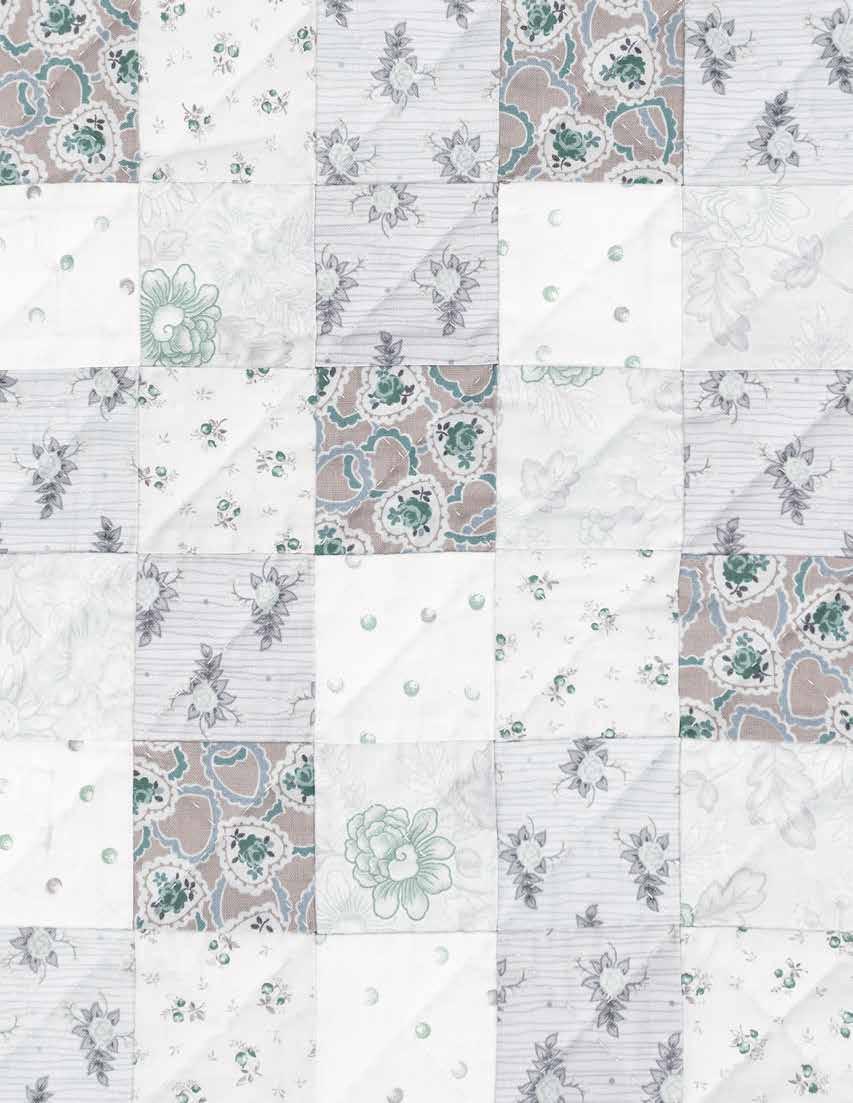
of Wellesley. I drove an hour and a half from our home to the auction and stood around all day, waiting for this lovely quilt to be offered. When the sale was nearly over, I approached the auctioneer, Murray Gerber, and asked, ‘When will the friendship quilt be offered?’
“The auctioneer replied, ‘I’m sorry, but the family has changed their mind. They want to keep the friendship quilt.’
“I said, ‘I drove a long distance to bid on that quilt. Shouldn’t an item that has been advertised for sale, be offered for sale?’ The auctioneer and family agreed and at the very end of the sale, they offered the quilt. And I bought it.”
Confident that this quilt was of Amish Mennonite origin and intrigued by the collector’s story, the next day I bought it by auction and took it home. Then began the fun of piecing together its backstory.
My first call was to the auctioneer who’d sold it decades ago. Murray Gerber of Crosshill is a well-known, highly respected auctioneer with expertise in early Ontario antiques. He remembered the quilt and confirmed the story, but said, “After five decades in the auction business, I just can’t remember at whose sale we first sold that old friendship quilt.”
“Nafziger” was the most common surname on the quilt. So, on a hunch, I called my old friend, Ron Nafziger of Brunner. I described the quilt to him. “Of course, I know that quilt,” he replied. “I was there when it was sold at my uncle’s estate auction. It created quite a kerfuffle… I know that my mother would love to see it.”
A week later I met Ron at Greenwood Court, an extended care facility in Stratford where his 98-year-old mother lived. Although confined to a wheel chair, Laura Nafziger’s mind was as sharp as a tack. When I pulled the quilt out of a bag and handed it over, Mrs. Nafziger gathered it into her arms like a long-lost friend. She
said with astonishment, “Where did you ever find this?” Not only did Laura remember the quilt, she recognized all the women who had embroidered a block and identified her mother-in-law, Emma (Mrs. Sam) Nafziger (1895-1974), as the quilt’s maker. Laura had married Emma’s son, Harvey, in September of 1939. Later that fall she attended a quilting bee at her mother-in-law’s house. “I was not asked to contribute a block to this quilt,” Laura said, “but I did help quilt it.”
Although art for the sake of art is not part of Amish culture, art is not absent from daily life. Personal adornment in clothing and hairstyles is strictly regulated, but women in the Amish community find other ways to express their artistic gifts and love of beauty. They plant picturesque flower beds and tend neat vegetable gardens. They hook rugs, embroider fancy pillow cases and make colourful quilts.
First appearing in the 1840s, friendship quilts were made to honour relationships among friends, classmates, relatives, or neighbours. Each participant embroidered and signed a block for the quilt top. Adding your signature to a quilt block was an expression of affection and attached sentimental value to a quilt long after the person had moved away or died.
Emma Nafziger was a busy homemaker, mother and Amish preacher’s wife when she set out to make her own friendship quilt. From how many family and friends she requested a signed quilt block, no one knows. What we do know is that she arranged the 15 signed blocks that she had received and sewed them together with strips of yellow cotton fabric to create her quilt top design.
All 15 names on the quilt were from Emma’s family, church or friendship circle. In keeping with the patriarchy of that time, the married women identified themselves by their husband’s names (Mrs. Sam Nafziger, Mrs. Jonas Jantzi, etc.). Over a third of the

Thank you for embracing Wilmot Township’s heritage and preserving it for future generations

519-669-2090
mike.harrisco@pc.ola.org
mikeharrismpp.ca
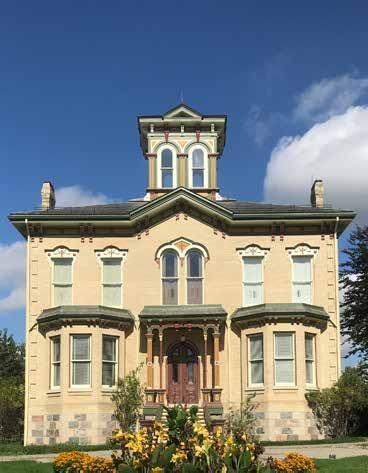
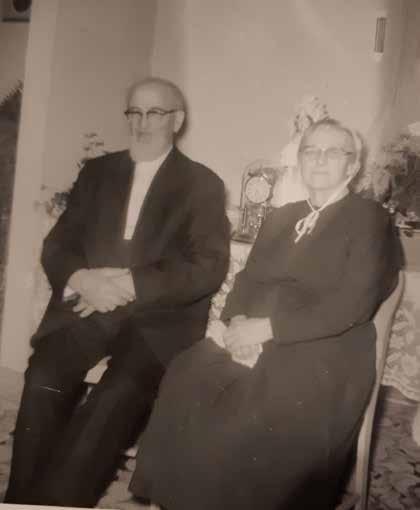





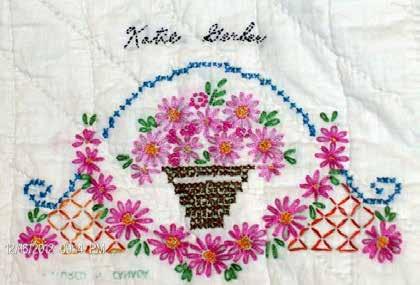
Like Seiling, Myers was bemused by this letter, which contained, out of the blue, an invitation for the municipality of St Agatha to send a delegation to Alsace, where they would be hosted, free of charge, by a group of local genealogists and political leaders It seemed that Michelle Spetz and her colleagues had traced the pioneer paths of some ancestral relatives to St. Agatha, Ontario, Canada, and they were interested in re-establishing that centuries-old connection.
blocks carry the surname “Nafziger” and represent Emma’s immediate family.
So, would the Mayor of St. Agatha lead a delegation to Alsace?
The idea sounded a little crazy – and perhaps it was. But the name Spetz rang some bells. After all, one of the key historic figure Theobald Spetz, a leader of th Waterloo Region. Father Spetz then Waterloo Township, but h
Emma placed the block bearing her parents’ names (Mother and Father Erb) in the centre of the quilt and sewed the patch from her young niece, Ruth Nafziger, into the upper left of the top row. Since along with her name, Ruth included her age as “seven years”, the quilt can be dated to 1938. Emma may have given place of honour to her young niece’s patch for another reason. Ruth was a beloved child who suffered a painful, congenital bone disease known as Brittle Bone Disease. Ordinary movement fractured her limbs and the multiple breaks required repeat castings. It was assumed that she would not be long for this world.
The sole surviving contributor to this quilt is 96 year old Katie (Gerber) Schellenberger. Katie grew up on a farm near Wellesley and was ten years old when she and her sister Emma embroidered blocks for their Aunt Emma’s friendship quilt. Katie made quilts into her 80s and is still an alert and engaging senior. Although carefully pieced and stitched, antique quilts were functional creations, made to be used. They often lasted only as long as the generation for which they were made. The Nafziger friendship quilt is a rare exception to this tradition.
Wilmot
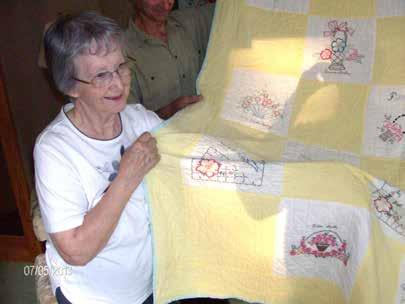


Showing few signs of wear and tear, the names set among colourful birds and blooms are still bright and clear. Presumably, Emma’s memory-laden quilt was tucked away in a cedar chest for decades. In old age, she gave it to her son, Ivan and his wife, Laureen who treasured Emma’s quilt for several more decades. Following Laureen’s death, her family arranged for Gerber Auctions of Crosshill to conduct a sale and sell their parental home and its contents. It was to this estate auction that the antique collector had come to buy the old quilt. After years of being appreciated in other families, I was able to buy the quilt and sell it back to the Nafziger family. A family member said, “We thought it was gone forever that day at the auction. always felt that we had somehow let down our mother… We are still amazed at the journey which this quilt has taken”. Emma Nafziger’s great granddaughter, Lisa Nafziger of Ottawa, is the current caretaker of this family heirloom. Stitched into Emma’s quilt with colourful threads are the names of those who were closest to her in life. Look a little deeper and Emma’s heirloom quilt is also stitched with those invisible threads of love and relationship that bind together all families and communities, one generation to the next.
dré, are descendants of relaSpetz family members who en their siblings and cousins ventured across the Atlantic But there are many other names, common in St. Agatha and Wilmot in general, that have their counterparts in Alsace, including Dietrich, Wagler, Erb, Yantzi, Mosburger, Albrecht, Fischer, Egli, Weber, Eby, Shantz, Gingerich, Gerber, Roth, Nafziger, Lichti, Wagner, Bruder, Strauss, Schneider, Hartmann, and more Alsace has a fluid past, sitting as it does on the borders of Germany and Switzerland Prior to 1674, Alsace had


 By Kristen Hahn
By Kristen Hahn
While people are largely familiar with the Freemasons, (their existence, if not their secrets), there were other fraternal organizations widely active in Wilmot such as the Foresters, their affiliate Knights of the Maccabees, and the Catholic organization Knights of Columbus. But chief among them was the Independent Order of Odd Fellows (IOOF) with a membership that rivalled that of those followers of “The Craft.”
Like the Masons, the Odd Fellows are believed to have started as a guild, but for the “odd” or smaller trades. Established in London, England, the first documents of an Odd Fellow lodge are the minutes from a March 12, 1748 meeting of the Loyal Aristarcus Lodge No. 9, (suggesting that there were another eight we don’t know about.) It thrived throughout the UK and made its way across the Atlantic when, in 1819, a British-American coachspring maker, Thomas Widley, assembled his fellow brothers at the Seven Stars Tavern in Baltimore, Maryland and started the Washington Lodge No. 1. The Americans split from the parent organization and founded the Independent Order of Odd Fellows in 1843; that same year a semi-sovereign chapter opened in Montreal, and it operated for ten years until its collapse in 1853. The orphaned lodges in Ontario were brought under the banner of the Grand Lodge of the United States and reorganized under a new charter for Canada West. The fraternity expanded to surging popularity across Ontario; at its peak in 1920, there were 403 lodges in the province with 61,833 members.



IOOF Degree Certificate, Township of Wilmot Archives. (Shirley Unrau collection)
The IOOF did not have such overhead, and their primary role in the community was to serve as a fraternal benefit order or “friendly society” – a precursor to today’s insurance companies. For an annual membership fee, a person would attend lodge meetings and ceremonies to strengthen the brotherly bonds of “Friendship, Love, and Truth.” Should they become sick, they might receive monthly financial support or avail themselves of an Odd Fellow doctor. Their brothers would visit them in their time of confinement (perhaps to ensure they weren’t faking their illness) and, upon their death, their burial expenses would be largely covered.
And it is to that first point – the bonds of brotherhood – that we see the more interesting, “secret society” aspects of this fraternity. With a toehold in guild organization, it was important to ensure that any secrets of the trade be shared among friends. Ceremonies, parables, regalia, tests, and trials – all helped to cohere the links between the members and root out any impostors.
In addition to being a guild of odd trades, some historians have posited the name may also have stemmed from the strangeness of their commitment to mutual aid when early 18th Century London was strictly divided by class, and few were seen to reach across these social boundaries to help their compatriots. To this day, the command of the IOOF is to “visit the sick, relieve the distressed, bury the dead, and educate the orphan.” We may normally associate these acts of charity with the church, however, during the mid-to-late 19th Century, religious organizations were unable to fill that role as they were often strapped for cash with the maintenance of the church, manse or parish house, and payment for the minister.
An example of a 1916 membership certificate inscribes a “telegraphic cipher and key” for IOOF members to communicate between lodges. Many of the code words relate to potential schemers: “black” indicates a fraud, “boat” means the member is expelled, “secretary” means his papers are fraudulent, “white” means he is an unknown. The remaining codes pertain to circumstances that may attend the member’s misfortune: whether a nurse may be hired, whether the deceased should be transported to his home or buried in whatever city he was found, and whether the widow should receive assistance.
The Township of Wilmot Archives has a certificate that commemorates the bestowment of a member’s degree and it is redolent with symbols. Two parables are depicted: the Good Samaritan and, somewhat more obscurely, the story of Jonathan and David to convey that when danger is present, a warning should be covertly given. The Ark of the Covenant and the Holy Bible are clear enough; the globe represents universality; the crescent moon and seven stars represent harmony and the tavern where the IOOF was founded; the beehive represents industry and common purpose. Somewhat hidden in the design are images of an hourglass (fleeting time),

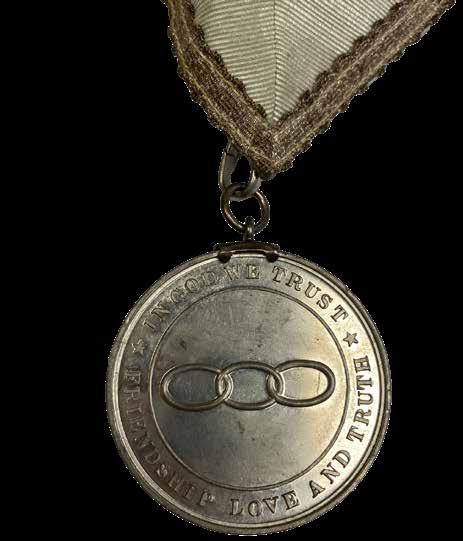






a quiver of arrows (preparedness), the Rod of Asclepius (medicine), an axe (progress), a skull and crossbones (memento mori), a bundle of sticks (strength in numbers), a scythe (death), and a three-linked chain (friendship, love, and truth). Over it looms the All-Seeing Eye or the Eye of Providence. Common to many Western fraternal organizations, it is shared by the Freemasons, the Illuminati, and famously appears on the American dollar bill.
In New Hamburg, the IOOF Nith Lodge No. 96 was founded on July 30, 1872, with the officials being: Noble Grand Louis Germann, Vice Grand Samuel Merner, secretary William Schaaf Sr., and treasurer Frederick Merner. They were among the most prominent citizens of New Hamburg at this time. Stationed in the Imperial Block, Germann was a hardware merchant and Schaaf purveyed boots, shoes, and liquor. The Merner brothers were land developers and key founders of industry in town. In this charter year for Nith Lodge, Fred Merner had just been succeeded by his older brother as Reeve of New

Hamburg and Samuel would go on to serve as a Member of Parliament and Senator under Sir John A. MacDonald. Other prominent Odd Fellows were Captain Frederick H. MacCallum, merchant and veteran of the Fenian Raids; Daniel Ritz, publisher of the New Hamburg Independent; Louis Hahn, founder of Hahn Brass; and Reeve Louis Peine, merchant of the Peine Block (adjoining the McCallum Block where currently sits the New Hamburg post office). Their first lodge was on the third floor of the Queen’s Arms Hotel (3 Waterloo Street, now only two storeys), from where they hosted card games, orations, musical performances, and grand balls with dancing well into the night. As membership grew, they relocated to a larger space at the Independent Block (112-120 Peel Street). It, too, was once three storeys tall, and the Nith Lodge was headquartered on the top floor with the main chamber measuring 50’ x 50’ with three large adjoining rooms, and hardwood floors throughout. At its time, it was considered the finest in Western Ontario.
Until one tragic day on July 22,
Starting with Zito Baccarani (uncle)
Continuing with nephew Gottfried (Fred) Langenegger, And his sons Tristano (Tootie) and Romano (Manny) 4th Generation Tristano’s sons, Tony and Mark
Today, Mark & his wife, Pat, continue with the specialty production of cheese including parmesan, cheddars, brick, cook cheese, limburger, cheese curds and much more.



OurHeritageHome-2021-3:River Rolls 6/3/21 5:33 PM Page 46
OurHeritageHome-2021-3:River Rolls 6/3/21 5:33 PM Page 46

1959. Shortly after noon, a fire broke out in a rear shed where two young boys were playing with matches. Fanned by a dry wind, the flames were quickly out of control and, within a few minutes, raced through the building as a four-alarm blaze.
Castle Kilbride is a meticu flects the opulence of a bygone era This Italianate mansion home to the Livingston fam credible number of original found their way back “home tle, historical accuracy is ach was completed that made th thentic
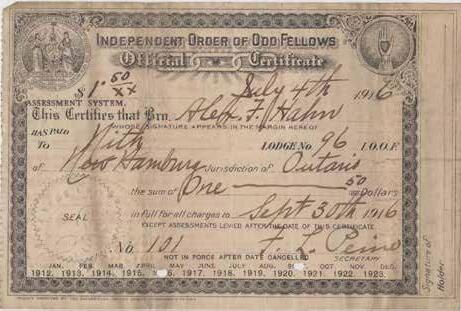
Castle Kilbride is a meti flects the opulence of a bygone era This Italianate mansion home to the Livingston fa credible number of origin found their way back “hom tle, historical accuracy is a was completed that made thentic.
Fire departments from Wellesley, Baden, and Kitchener came to the aid of the local volunteers. It was feared nearby buildings were in jeopardy, however, the real toll was far more serious. It was a warm summer day, and the apartment windows were all open, pulling, like a chimney, the thick smoke into the second-storey dwellings. Dead from asphyxiation were Trudy Crabbe, her two small children – Robert, aged four; and Linda, aged two – and Trudy’s sister-in-law, Alice Matthews.
At its opening in 1994, ric installed in the main hallwa décor but were not historica tors knew from earlier decor dants and from looking at p restoration, that Castle Kilb oilcloth on the floor. Oilcloth would be incredibly appropr ated by utilizing linseed oil ( the very product that made ing the fine calibre of oilclot seemed like an impossible q support for this project, it became a reality.
At its opening in 1994, r installed in the main hallw décor but were not histori tors knew from earlier dec dants and from looking at restoration, that Castle K oilcloth on the floor Oilclo would be incredibly appro ated by utilizing linseed o the very product that mad ing the fine calibre of oilcl seemed like an impossible support for this project, it became a reality.
From the time they responded until the wee hours of the morning, firemen fought to control the inferno. They were called out twice the following day – and once again on the third day – before the embers were completely extinguished. The entire third floor was consumed and the lodge for the Independent Order of Odd Fellows was lost.
Artist Lori LeMare, who masterfully aided the repair of some of the Trompe l’oeil murals at Castle Kilbride, had also recreated an oilcloth for a Hamilton museum. From that moment, staff began exploring the possibility of an oilcloth for Wilmot’s National Historic Site There were photographs from the 1980s that showed an embossed red oilcloth covering the entire floor and a runner up the staircase According to the Livingston descendants, this flooring was likely installed in the 1950s. To showcase a late 19th century floor covering, the
cloth began staying true to the origg

cloth began staying true to the orig-
g
agencies, mutual aid societies were no longer required and, unlike the Foresters who continue to do business today as Foresters Financial, the IOOF was unable to make the shift to something the marketplace would find useful. Furthermore, the 1960s saw an explosion of new social clubs. It was a decade that saw rapid changes rocket across New Hamburg and the world. The spirit of the time was youthful, exuberant, and modern; it was not a time for fusty old fraternities, and anyone with a penchant for esotericism and ceremony gravitated towards the Masons.
The new floor covering in Castle Kilbride's front hall.
The new floor covering in Castle Kilbride's front hall
The Odd Fellows were left the odd man out.
SOURCES:
M. Voisin et al, The Historic Buildings of New Hamburg and the People Who Lived in Them (New Hamburg, ON: Voisin Publishing, forthcoming publication)
Township of Wilmot Archives, New Hamburg Independent microfilm collection
Artist Lori LeMare, who masterfully aided the repair of some of the Trompe l’oeil murals at Castle Kilbride, had also recreated an oilcloth for a Hamilton museum. From that moment, staff began exploring the possibility of an oilcloth for Wilmot’s National Historic Site. There were photographs from the 1980s that showed an embossed red oilcloth covering the entire floor and a runner up the staircase. According to the Livingston descendants, this flooring was likely installed in the 1950s To showcase a late 19th century floor covering, the
IOOF Membership Certificate (front and back). (Hahn Family archive)
W. H. Ford, Symbols of Odd-Fellowship (Providence, RI: self-published, 1904)
used while wet, to give the ing this, two layers of deburgundy were applied. t embellishments that of the Castle’s ceiling. An he entire cloth followed by ensure its longevity Once o, the artist transferred the he onerous task of installing ted cloth. h, the contractor created a d cut it to perfection, leaving on. Keeping in the spirit of the heritage project, traditional nails from the era were used to secure the cloth along the perimeter While preparing the hallway, the contractor discovered previous holes on the original wood floor, and it is believed that the Livingston family had installed at least two different oilcloths in the past 140 years.
used while wet, to give the ing this, two layers of deurgundy were applied t embellishments that of the Castle’s ceiling An he entire cloth followed by ensure its longevity. Once o, the artist transferred the he onerous task of installing ted cloth. h, the contractor created a d cut it to perfection, leaving on. Keeping in the spirit of the heritage project, traditional nails from the era were used to secure the cloth along the perimeter. While preparing the hallway, the contractor discovered previous holes on the original wood floor, and it is believed that the Livingston family had installed at least two different oilcloths in the past 140 years
In 1960, the IOOF acquired the Regent Theatre at 97 Wilmot Street and held their lodge meetings there until 1969; however, the fraternity was already in decline. With the dominance of insurance
P. H. J. H. Gosden, The Friendly Societies in England, 1815-1875 (Manchester, UK: Manchester University Press, 1961) grandlodgeofontario.ioof.net (Retrieved March 11, 2024) odd-fellows.org (Retrieved March 11, 2024)
After a week of installation, the new flooring was unveiled in October. Despite the highly artistic look, it is meant to be walked on.
After a week of installation, the new flooring was unveiled in October. Despite the highly artistic look, it is meant to be walked on.


Sometimes coincidences can take you off guard. One such happenstance occurred when I was researching the Umbach family that had lived in New Hamburg. I was exploring the family of Rev. Joseph Umbach when I came across a notation that one of his sons, Moses, had moved to Corpus Christi, Texas. Texas is a very large state, but I happen to know Corpus Christi well; in fact, several of my good friends live there. I asked one of these friends about Moses Menger [Umbach] and she knew of him as he had been paramount to creating the school system in Corpus Christi. I was surprised once again in January of 2024 when an article, written by Corpus Christi reporter, Robert Parks, appeared on the local television station, KRIS 6 NEWS about Moses Menger.(1) Who knew that Moses Menger was honoured and considered the Rock Star of the Corpus Christi’s educational system?
Of all of Rev. Joseph Umbach’s children, Moses had the most interesting story, primarily because he made up for careless mistakes of his early years in his later years.
This is the story of the Umbach family’s immigration to Canada; it is one of many stories of resilience, determination, survival, and success of immigrant families in a new land. John Umbach emigrated from Germany with his family to Canada so his sons would not have to fight in the German army and would have a chance to live freely:
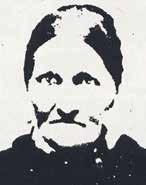
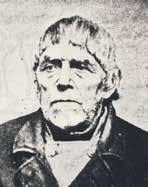
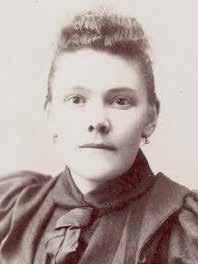
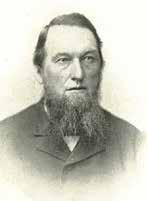

In the pretty village of Grosgortig, Wurterburg, Germany, lived Gottlieb [ John] Umbach. Early in his youth, he took a job as a shepherd near Stuttgart. While in charge of the flock, he had the opportunity to watch soldiers drill. Seeing the cruelty inflicted upon them for the simplest offenses, he determined never to join the army.
While Napoleon advanced across Europe and added territory after territory to his domain, John, a youth of 17, was drafted into service. He objected and fled to Baden, where he found employment [as] a shepherd, [a] vocation he followed until he came to America. While in Baden in 1822, he met and wedded Katharine, daughter of Conrad Laschinger. Katherine was born in the beautiful village of Moenichzelt, nine miles north of Heidelberg. Limited means made it necessary for her to leave the parental home and serve as a maid.
The young couple, having learned the lesson of economy, soon were in the possession of a good house and income. During the summer months John took his flock to the banks of the Rhine and left Katherine to care for the house, farm and four sons. When the oldest, Conrad, had to enlist as a soldier, [John], who had an aversion to military service, decided it was time to leave Germany. In the spring of 1843, the Umbach family (John 45; Katherine 38; children Conrad 18; Joseph 13; Frederick 10; and Johann Gottlieb 4) set sail from Rotterdam on ‘The Historian’ and after fifty-four
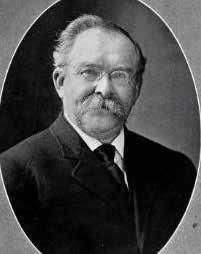







days of a stormy voyage, they reached New York on July 12, 1843. Katherine was pregnant with Jacob on her voyage to America. From New York, they travelled to Woolwich Township where the father-inlaw, Conrad Laschinger, had located eight years previously. The rough forest country did not appeal to John Umbach, and he had hoped to return to Europe. However, in the course of time he reconciled to the conditions and purchased 250 acres in Woolwich Township. John later died of old age in 1878 at the age of 89. Katherine died at the age of 69, also of old age.(2)


For the purpose of this article, the focus will be on John’s son, Joseph Umbach (1829 Germany-1911 New Hamburg) and his family. While Joseph lived in Woolwich and helped his father farm their land, he met his future wife, Elizabeth Menger [1834 Germany-1906 NH]. Her parents, Michael Menger and Susanna Kirsch, had sailed to New York on the ship, ‘C. Whitney’, on August 13, 1846. They too bought a farm in Woolwich and lived there until the 1860s when they moved to New Hamburg.
Joseph and Elizabeth Umbach married in 1852 in Woolwich and moved to New Hamburg where Joseph became the minister in the Evangelical Church for many years. He built a house at 299 Bleams Court in 1871 and lived there until 1901 when they moved to a frame house at 312 Peel Street (it no longer exists). From 1902-1904, they lived at 305 Wilmot Street. Their last address was 179 Peel Street where they lived from 1904-1910.
Elizabeth lived to the age of 71. She had had problems with her heart for ten years prior to her death; her death notice reads: “On Thursday morning she was suddenly stricken with paralysis and passed peace-
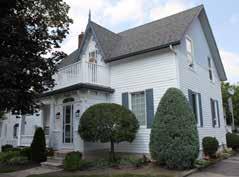
305 Wilmot Street where Joseph Umbach lived from 1902-1904, and later belonged to his daughter Mary Ann and her husband, John Kaercher
fully away on Friday evening. Deceased was born in Mauer, Baden, Germany, and came to this country with her parents when 12 years old, and settled in Woolwich… Mrs. Umbach was for the past 38 years a highly respected citizen of this town and a devoted member of the Evangelical church. She leaves to mourn her demise her sorrowing husband, 4 sons, 4 daughters, 23 grandchildren and 2 great grandchildren. The funeral took place on Tuesday afternoon from her late residence to the Evangelical church, where the funeral services

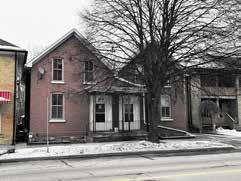
179-181 Peel Street, home of Joseph Umbach, 1904-1910
were conducted… thence to the Evangelical cemetery.”(3)
Joseph had several health scares during his later years: “Rev. Joseph Umbach underwent a critical operation Thursday morning, which was successfully performed by Dr. Eckel of this town, Dr. Walters of Berlin and Dr. Ford, of Shakespeare. Owing to the patient’s advanced age the operation was considered dangerous, but at last reports was doing well and chances for recovery are now favourable.”(4)
In 1911 at the age of 81, he died from a stone in his gall bladder. He had had several operations for reoccurring infections in his kidneys and bladder.(5)
According to Elizabeth’s obituary, Joseph


& Elizabeth Umbach had 12 children [but there were 13]:
1. Professor Levi Menger Umbach [1853-1918 Illinois]
2. Mary Ann [1855-1937]
3. Moses Menger [18601920 Corpus Christi, Texas]
4. Otto Menger [1861 NY1943 Kitchener]
5. Johanna [1863 Buffalo-1903 NH]; she married Herman Appel
6. Sarah Catherine [1866 NH-1950 Galt]; in 1885 she married Rev. Emil Becker
7. Adeline [1869 NH-1933 St. Jacobs]; she was a seamstress and married Anthony Gies in 1893
8. Laura Evelyn [1870 NH1920 Stratford]; she married Jacob Beilstein
9. William Henry [1871 Woolwich-1922 Illinois]
10. John Walter [1874 NH-1874 NH]
11. Helena Rosina [1875 NH-1877 NH]
12. Telma [1876-1877]
13. Edgar [1879 NH-1879 NH]
Their first son, Levi Umbach, became a professor at North-Western College in Naperville, Illinois (a rich Chicago suburb) where he gained distinction as a scientist in the field of Biology. He served on the
faculty for almost 40 years until he died in 1918. In 1897, he donated 250 plants to the New Hamburg Public School for the purpose of starting a herbarium. This donation was timely as botany was being introduced to the public-school curriculum the following year.(6)
Joseph and Elizabeth’s first daughter, Mary Ann Umbach’s first husband, Michael Edighoffer, died of consumption at the age of 29. She then married John Kaercher and had four children. John was a wagon maker at The Beger Carriage Works and later worked for Frederick Merner making carriages. Mary Ann was a member of the Ladies Aid and Women’s Missionary Society in 1919; Church Secretary for the Evangelical Church in 1893; Church Treasurer and Collector for the Evangelical Church in 1901-02. The Kaerchers purchased 305 Wilmot Street in 1882 and retained ownership until 1933. Mary Ann died in Collingwood at the age of 82 from coronary thrombosis.
The third child, Moses Menger Umbach, the most noteworthy of Joseph’s children, began his career as a teacher in New Hamburg. He made two major mistakes in his early years and spent the rest of his life making up for them. In 1880, he enlisted in the U.S. Army on June 28, in Buffalo


The beginnings – In 1979 A humble farmer and his wife, Waldron & Doreen Eckstein, developed innovative machines to process their raw materials; which led to Waldron’s invention of the VERS-A-BELT Dryer offering solutions for hundreds of clients in agriculture, forestry, and fishery.
In 1983 sons, Wayne and Mark came to help their parents fabricate dehydrators. A few months later, Wayne and Mark provided metal fabrication. Since then, Wal-Dor Industries has provided metal fabrication solutions for local companies, farm repairs and manufacturers, including Toyota, Honda, and GM.
In 2003 Wayne and Mark took ownership of Wal-Dor Industries.
Since Waldron’s recent retirement he often visits the shop to keep current on the industry and the custom projects the boys are working on. Their mother, Doreen, passed away 2017.
Today Wal-Dor Industries supplies metal fabrication services for manufacturing, agriculture, and construction and they have shipped dehydrators throughout the world.






Castle Kilbride is a meticulously decorated museum that reflects the opulence of a bygone era This Italianate mansion, home to the Livingston family from 1877 to 1988, boasts an incredible number of original artifacts, many of which have since found their way back “home” through donation. Little by little, historical accuracy is achieved And this past fall, a project was completed that made this museum that much more authentic.
stating he was a 21-year-old bookkeeper. He had blue eyes, dark brown hair and fair skin. He was 5’ 8” tall. He deserted from the army on September 18, 1881, because he wasn’t being paid by the Army and he returned to Ontario. However, he became a wanted man in the U.S. because of this. One might wonder why he chose to become part of the American army – it could possibly be that he was influenced by his maternal uncle, W. Mathias Menger Sr. who moved to New Orleans by 1862 and who fought with the Confederates in the Civil War. (By 1870, Mathias settled in Jefferson and later Marshall, Texas [an important Confederate town during the Civil War] where most of his children remained).
Castle Kilbride is a meticulously decorated museum that reflects the opulence of a bygone era This Italianate mansion, home to the Livingston family from 1877 to 1988, boasts an incredible number of original artifacts, many of which have since found their way back “home” through donation Little by little, historical accuracy is achieved. And this past fall, a project was completed that made this museum that much more authentic
At its opening in 1994, rich burgundy carpet runners were installed in the main hallway. They tied in nicely with the décor but were not historically accurate Castle Kilbride curators knew from earlier decorating trends, talking with descendants and from looking at photos of the home during restoration, that Castle Kilbride would have featured a large oilcloth on the floor Oilcloth was common to this era, but also would be incredibly appropriate, as oilcloth flooring was created by utilizing linseed oil (a derivative from flax), which was the very product that made James Livingston wealthy. Matching the fine calibre of oilcloth that once graced Castle Kilbride seemed like an impossible quest, but after much research and support for this project, it became a reality.
When Moses returned to Ontario, he fathered a daughter out of wedlock, Maggie Umbach Lake, who was born in February 1886 and died in May 1886 of infantile debility. She was buried at the House of Industry and Refuge in Berlin (now Kitchener). Her mother was Elizabeth Lake (1865 ON-1895 Kitchener) and Moses did not marry her; in fact, he left her to fend for herself. This was Moses’ second regret that he had in life.
At its opening in 1994, rich burgundy carpet runners were installed in the main hallway. They tied in nicely with the décor but were not historically accurate Castle Kilbride curators knew from earlier decorating trends, talking with descendants and from looking at photos of the home during restoration, that Castle Kilbride would have featured a large oilcloth on the floor. Oilcloth was common to this era, but also would be incredibly appropriate, as oilcloth flooring was created by utilizing linseed oil (a derivative from flax), which was the very product that made James Livingston wealthy. Matching the fine calibre of oilcloth that once graced Castle Kilbride seemed like an impossible quest, but after much research and support for this project, it became a reality.
Artist Lori LeMare, who masterfully aided the repair of some of the Trompe l’oeil murals at Castle Kilbride, had also recreated an oilcloth for a Hamilton museum. From that moment, staff began exploring the possibility of an oilcloth for Wilmot’s National Historic Site There were photographs from the 1980s that showed an embossed red oilcloth covering the entire floor and a runner up the staircase. According to the Livingston descendants, this flooring was likely installed in the 1950s. To showcase a late 19th century floor covering, the
On December 31, 1889, Elizabeth Ann Lake (age 24) married Menno Beight (age 31) in Berlin, Ontario. Menno was born in The United States. The marriage record stated: “The Bride was adopted by John Spahr of New Hamburg when quite young and does not know her parents’ names.” John Spahr Sr. was a farmer in Perth County until he retired to New Hamburg. It is unknown how he came to adopt Elizabeth. Menno and Lizzie had a daughter, Elsie who was born on December 22, 1890, in Berlin. Elizabeth died in 1895, in Berlin, at the age of 29. The cause of death was blood poisoning. There is no headstone over her grave. A Find a Grave search for Menno and Elsie reveals that they moved to Iowa (possibly Menno’s native State) after Elizabeth’s death. Menno married again, and Elsie died at age 13. Meanwhile, Moses returned to the U.S. but took his mother’s surname so he would not be captured by the Army. He became known as Moses Menger and settled in Texas. Since he was very clever in Mathematics, he became a teacher in Austin, then Flatonia, Hallettsville and Corpus Christi. He remained in Corpus Christi where he later became a principal and superintendent of the Cor-
Artist Lori LeMare, who masterfully aided the repair of some of the Trompe l’oeil murals at Castle Kilbride, had also recreated an oilcloth for a Hamilton museum From that moment, staff began exploring the possibility of an oilcloth for Wilmot’s National Historic Site. There were photographs from the 1980s that showed an embossed red oilcloth covering the entire floor and a runner up the staircase According to the Livingston descendants, this flooring was likely installed in the 1950s. To showcase a late 19th century floor covering, the


artist decided to draw inspiration from the beautiful 1878 murals that gr
artist decided to draw inspiration from the beautiful 1878 murals that g th w ti w im se cl in 1 st la
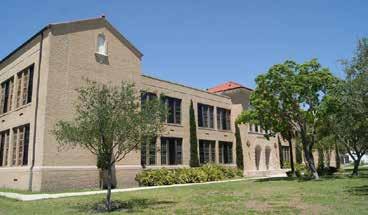
pus Christi Independent School District. In 1929, the school board built Menger Elementary School after their former superintendent. (7) He became one of the most highly respected educators in the city and the state.(8)
He married Nancy Overton in 1888 in Lavaca TX and had two sons, Overton and Garnett; a year after Nancy passed away, he married widow, Cora Lucile Carroll Allen in 1901.
were used along with a stiff brush, used while wet, to give the look of a directional weave Following this, two layers of detailed stencil work in a very dark burgundy were applied. Then came the beautiful gold paint embellishments that matched the 24 karat gold details of the Castle’s ceiling An antiquing glaze was applied over the entire cloth followed by five coats of a protective coating to ensure its longevity. Once the cloth was cured and ready to go, the artist transferred the piece to a heritage contractor for the onerous task of installing this massive single piece of decorated cloth.
were used along with a stiff brush, used while wet, to give the look of a directional weave Following this, two layers of detailed stencil work in a very dark burgundy were applied. Then came the beautiful gold paint embellishments that matched the 24 karat gold details of the Castle’s ceiling. An antiquing glaze was applied over the entire cloth followed by five coats of a protective coating to ensure its longevity Once the cloth was cured and ready to go, the artist transferred the piece to a heritage contractor for the onerous task of installing this massive single piece of decorated cloth
Moses died of carbuncles, contributed by diabetes in Corpus Christi in 1920 at the age of 59. The city asked all businesses to be closed for his funeral.(9) He more than redeemed his mistakes of his early years by the work he had completed for the school system in Corpus Christi. He is still revered in Corpus Christi for his contribution to their schools.(10)
Using the finished, painted cloth, the contractor created a full template of the main floor, and cut it to perfection, leaving no room for error during installation. Keeping in the spirit of the heritage project, traditional nails from the era were used to secure the cloth along the perimeter. While preparing the hallway, the contractor discovered previous holes on the original wood floor, and it is believed that the Livingston family had installed at least two different oilcloths in the past 140 years.
Using the finished, painted cloth, the contractor created a full template of the main floor, and cut it to perfection, leaving no room for error during installation. Keeping in the spirit of the heritage project, traditional nails from the era were used to secure the cloth along the perimeter While preparing the hallway, the contractor discovered previous holes on the original wood floor, and it is believed that the Livingston family had installed at least two different oilcloths in the past 140 years
After a week of installation, the new flooring was unveiled in October. Despite the highly artistic look, it is meant to be walked on. in
After a week of installation, the new flooring was unveiled in October. Despite the highly artistic look, it is meant to be walked on. in
Otto Umbach, the fourth child of Joseph and Elizabeth, received his education in New Hamburg and became the bookkeeper for the Waterloo Manufacturing Company. He married Sophia Stahl in 1885 and had three children. Sophia passed away in 1936; Otto followed her in 1943 after being ill for about 5 years. He died of uraemia.
Johanna Susanna Umbach was the fifth child of the Umbachs. She

married Herman Appel in 1884 in New Hamburg and had two children. Herman had begun working in Becker’s store and transitioned into a dry goods partnership with John Katzenmeier and later, with Emmanuel Helmuth. Herman was the church secretary for the Evangelical Church from 1901-1908 and was later appointed auditor of New Hamburg in 1921. Johanna died in 1903 in New Hamburg at the age of 40 from an aseptic prolapsed pregnancy; her baby, Rose Violet, also perished with her. Herman lived to the age of 82 when he died in 1938 of nephritis.
Sarah Umbach, the sixth child, married Rev. Emil Dahlman Becker in 1885 in Waterloo. In keeping with the Evangelical influence upon their family, one of their children, Harrison Charles, became a minister in the Church. They had three other children. Emil died in 1933 and Sarah passed away in 1950 at the age of 84. She had been a member of the Ladies Aid, Women’s Society of World Service and the Women’s Christian Temperance Union.
Adeline Umbach, the seventh child, was listed as a seamstress in the 1891 census. In 1893, she married Anthony Gies who was a farmer, coal and feed merchant and bailiff in Kitchener. They had two children. Adeline died of stomach cancer in 1933 in St.
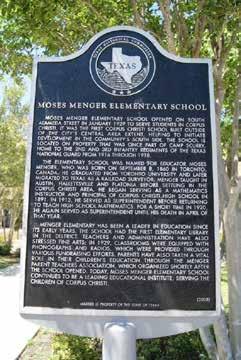
Jacobs where they had lived for 14 years. Anthony died at age 77 of coronary thrombosis in 1948.
Laura Evelyn Umbach was the eighth child who married New Hamburg resident Jacob Beilstein in 1891. Jacob was a talented house painter who also had painted horses, wild animals etc. on threshing machines
and a peacock on the screen door of his home. Their children numbered six. They lived at 285 Wilmot Street from 1893-1895 and at 204 Jacob Street from 1896-1913 and at 258 Wilmot Street in 1914. Laura died in 1920 of heart problems at the age of 50. Jacob followed her in death in 1944 at the age of 77.
William Henry Umbach was the ninth child of Joseph Umbach. He received a Bachelor of Science in Indiana before marrying Amelia Schaefer of Illinois in 1899. Both William and Amelia sang in the Evangelical Church choir in New Hamburg. They built a house at 448 Huron Street in June 1907 and lived there until 1914. They rented 308 Peel from 1919-1920 and lived there with their daughter, Ruth. William was one of the directors of The New Hamburg Felt Boot Company Limited when it was incorporated in 1905.
The next four children died as infants: John Walter lived from March to September of 1874; Helena Rosina lived from August 1875 to April 1877 and died from angina; Telma lived from August 1876 to April 1877 and died of angina; and Edgar who died of cramps, six days after his birth.
John and Katherine Umbach’s immigration to Canada was indeed the right decision for his family. They all prospered and

 Plaque in Corpus Christi honouring
Moses Menger (courtesy Robert Parks)
Plaque in Corpus Christi honouring
Moses Menger (courtesy Robert Parks)
lived freely. This is especially true for his son Joseph and his family. Joseph’s daughters married men who became prominent in New Hamburg and his sons achieved wealth and distinction as well. Not all families did this well when they began their lives in Canada; however, even though John was a mere shepherd in Germany, he encouraged his children to do their best in their new land. Umbach might not be a name that you see in New Hamburg anymore but over 100 years ago, it was well-known in town. The Umbachs are one of many families who helped build New Hamburg but who now are largely unknown.
Luckily through an enterprising reporter in Corpus Christi, answers were supplied about the life of Moses Menger [Umbach] and this brought a conclusion to the lives of Joseph Umbach’s family’s survival in North America.
(1) Robert Parks, “Moses Menger: A story of redemption”, KRIS 6 NEWS, January 18, 2024.
(2) National Archives. Series M237, microfilm #52, family #30119888
(3) New Hamburg Independent. February 23, 1906.
(4) New Hamburg Independent, November 15, 1906
(5) Ontario Death Record, #11-031332
(6) New Hamburg Independent, October 22, 1897
(7) Robert Parks, “Moses Menger: A story of redemption” KRIS 6 NEWS. January 18, 2024.
(8) Ibid.
(9) Ibid.
(10) Ibid.


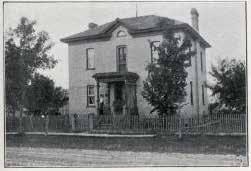
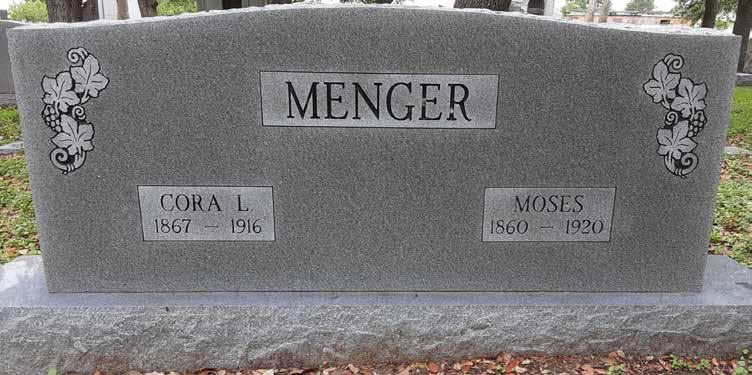 448 Huron Street built by William H. Umbach
Otto Umbach’s house in Elmira
Moses Menger’s tombstone in Corpus Christi (courtesy Robert Parks)
448 Huron Street built by William H. Umbach
Otto Umbach’s house in Elmira
Moses Menger’s tombstone in Corpus Christi (courtesy Robert Parks)








Drs. Kim and Howard Dolman, celebrating 30 years in business. (Paul Knowles photo)
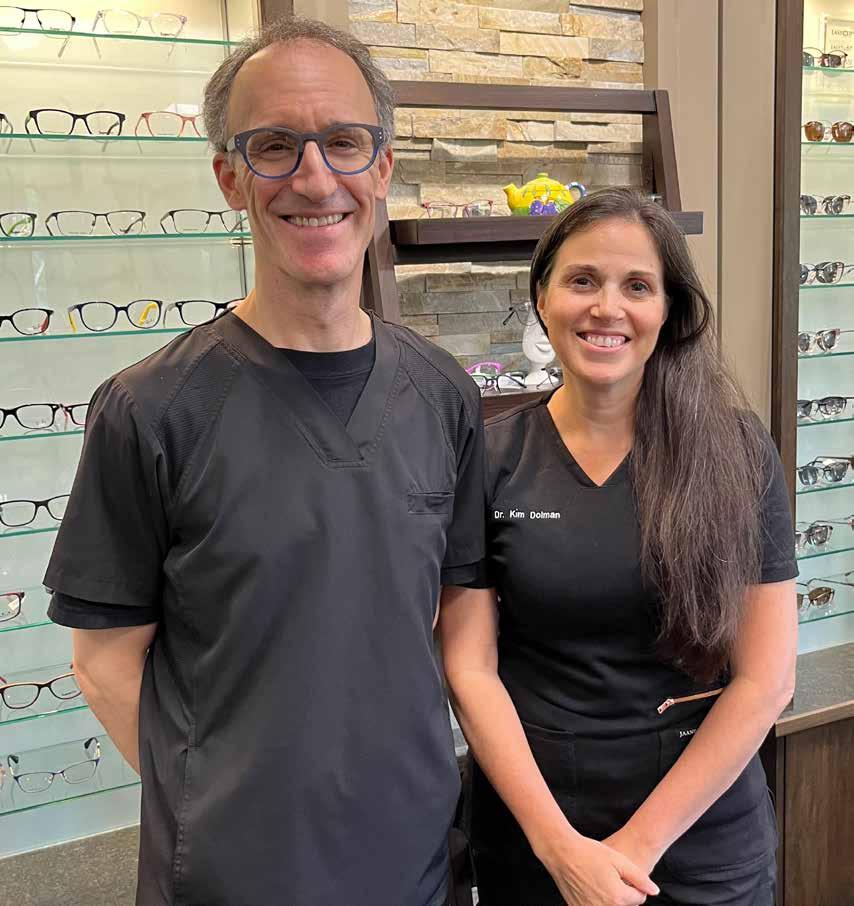
Drs. Kim and Howard Dolman are celebrating the thirtieth anniversary of their New Hamburg optometry business, Dolman Eyecare Centre. But they are keenly aware that their three decades represent only one stage in a much longer history of the business. They officially became owners of the practice on September 9, 1994. Prior to that, both Howard and Kim had been associates of the well-known optometrist, Dr. Betty Fretz, from whom they bought the clinic.
Dr. Fretz, in turn, had purchased the practice from long-time New Hamburg optometrist, Dr. Don Zarnke, in 1976. Dr. Fretz passed away in 2018; Dr. Zarnke died in 2014, at the age of 86.
When Kim and Howard talk about the history of their practice, they are quick to acknowledge the foundations laid for them by both Dr. Fretz and Dr. Zarnke. But they also admit that there has been something a bit complicated about the business transitions, every time!
It seems that when Betty Fretz decided to buy Don Zarnke’s prac-
Our
tice, Dr. Zarkne was ambivalent about selling. So, as a new graduate from the School of Optometry at the University of Waterloo, she pivoted, and opened a practice in Listowel, on July 13, 1976. But Dr. Zarnke decided to follow through with the sale, so by the next day, she also had a practice in New Hamburg.
Dr. Fretz was an iconic character in both communities. She participated in mission trips, was a noted horticulturalist, and made such an impact on her professional field that the organization Vision Therapy Canada has named a scholarship in her honour.
Howard Dolman says that she was ahead of her time in the field of optometry, adopting new technology long before more of her colleagues. “Dr. Fretz was leading-edge,” says Howard.
Nonetheless, when the Dolmans decided to buy the New Hamburg practice from Dr. Fretz, it wasn’t a state of the art transaction – the process took almost two years, and to the Dolmans’ surprise, Dr. Fretz moved the practice across Huron Street, to the current location, in the midst of their discussions. The new location opened in the spring of 1993; the Dolmans officially took over the practice in September 1994.
They were supposed to sign the deal on September 1, 1994. That didn’t happen, because on that date, Kim gave birth to their first child, Sarah, and the finalization of the deal had to wait nine days.
But Kim says that established the work-life balance pattern for all the years to come. “Sarah came first,” she says. Howard adds, “Family always comes first.” In fact, the couple have made sure that each has days off during the week for family time. They have four children.
Howard and Kim both graduated from the University of Waterloo School of Optometry, Howard in 1990 and Kim in 1992. They then joined Betty Fretz’s clinics as associates.
Kim says they chose optometry – which demands an undergrad-

in 1994.


This land was originally part of the Ray Baechler property (225 Huron Street) where his barn was located. Ray sold the property to Ted Stock and in 1963 Ted built a new structure which housed a creamery to the rear and a Fattum’s grocery store to the front. During those years, Ray picked up and delivered eggs to Loblaws and Dominion stores in Toronto. In 1963, Ray sold his egg route and truck to Vernon Erb from a newspaper ad.
Later, Frank Erb and Merv Roth bought the property and turned it into an egg grading station, Erb’s Eggs.
In 1987 ��re destroyed the egg grading station and Erb’s Eggs sold the business to LH Gray in Strathroy.
Merv Roth renovated the building and turned it into what it is now.
In 1993 Dr Betty Fretz remodeled the rear part to become an optometry o���ce. And in 1994, Drs. Howard and Kim Dolman purchased the clinic.
Today, Drs. Howard & Kim Dolman continue to o�fer residents of the area “state of the art” eye care services.

uate degree and then four more years of post-graduate study – because “It’s a nice mix of a medical career with a little more control over your own destiny.”
When they assumed the practice, they had five staff members plus four part-time optometrists; today, staff size has tripled. Many of the original staff remained on their team right up to retirement. At least one is still with them today, 41 years after coming to the business. The Dolmans say that this kind of continuity helped the transition from Dr. Fretz. “The team didn’t change,” says Kim.
She adds, “We try to combine the small town feel with big city services and technology.”
In their 30 years in business, the technology has seen dramatic changes, and that’s good. But both Dolmans say that changes in OHIP coverage have not been so positive. “It keeps us underfunded, and makes us be the bad guys” as optometrists are forced to explain to clients why some important tests have to be paid for out of pocket. The Dolmans argue that



with our health care system, people should have the right to expect to get the care they need.
Kim adds that one positive development is that optometrists now have the ability to prescribe medications. “We fought for that for 20 years.” And speaking of such fights, Howard has played a role on both the provincial and federal stages, involved with both the Ontario Association of Optometrists and the national Independent Optometry Clinics organization. And following in the footsteps of his mentor, Dr. Fretz, Howard has volunteered in a charitable eye clinic in Jamaica.
Kim has served for many years as part time clinical faculty at the University of Waterloo School of Optometry.
Today, they say, they are continuing on the path they began 30 years ago, providing professional and up to date service to their expanding list of patients. And because of some retirements among their staff, Kim adds that, “we’re going through transitions,” and are focused on “getting that strong base again.”

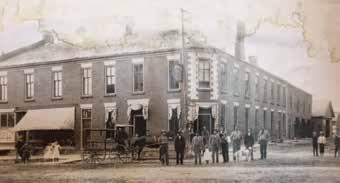
This 1872 hotel was totally restored from 2014-2016 and now contains 12 elegant onebedroom apartments for seniors; the main floor features commercial space for A Portuguesa Bakery, Peel Street Beverages [Brewery], Imperial Market & Eatery and Stonetown Travel.

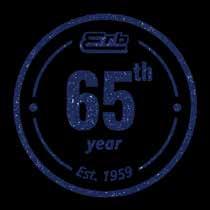
https://shorturl.at/deKO5



Twenty-nine years ago, Blaine Bechthold heard a rumour. The Township of Wilmot, it was reported, “was going to get rid of the old fire trucks.” Says Blaine, “I thought, that can’t be.” There was too much local history invested in those vehicles, he decided, so he contacted six other former fire fighters, and they founded the Wilmot Heritage Fire Brigades.
They saved the trucks, and eventually several others, and restored and maintained them so well that all continue to be licensed and roadworthy. They also began collecting other fire department artifacts and memorabilia – a lot of it.
Today, thousands of items in that collection are jam-packed into two small buildings behind the current Baden Fire Department. The group – which now numbers 86 members – makes every effort to show off the collection, hosting individual, group and school tours, and opening to the public
every Saturday morning from June through August.
They are focused on carrying out their two-fold mission, which is “To restore, maintain and preserve historical firefighting vehicles, equipment and documents. [and] To promote and educate the public in the heritage of firefighting in Wilmot Township in particular, and the firefighting service in general, by displaying historical firefighting vehicles, equipment and documents.”
But there is a problem, and it’s summed up in the phrase “jam-packed”. The truly fine collection of historic fire-fighting artifacts needs a much bigger home. Not only to display the impressive collection, but also so the volunteers can continue their mission of repairing and restoring these irreplaceable vehicles and equipment.
Peter Gingerich, another former volunteer firefighter who is one of the leaders of the Heritage Brigades, says that the orga-
nization continues to receive donations of equipment, “and occasionally, we get some cash.”
They are grateful for the donations of equipment and memorabilia, but the time is come, say Peter and Blaine, that cash will have to be the big focus – because the need for a new home is urgent.
The organization, which is a registered charity, does a lot of fundraising, simply to allow them to continue to restore and repair the artifacts. They run a monthly 50/50 draw, they collect and sell electronic waste, and cans and bottles. They sell memberships – at $10 each. Visitors can buy a hat for ten bucks, a pin for five.
But when it comes to public funding to support the cause of saving and displaying the history of Wilmot’s three volunteer fire companies – New Hamburg, Baden and New Dundee – the supply is virtually non-existent. Blaine says that they do receive $1545 in provincial funding annually. But asked how much they get each year from the Township of Wilmot – whose history they are working to preserve – the answer is “zero.”
The township does lease one of their buildings to them for $1 a year – the Brigades owns the other – but the leased building has required so much repair and upkeep that it has absorbed a lot of their fundraising over the years.
Peter says that the problem goes beyond jam-packed storage at their site at 10 Bell Drive in Baden. They have actually had to sell off two vehicles because they had no place to keep them. They still have six heritage trucks. An antique pumper is on loan to the Ken Seiling Museum at Doon; and other vehicles and equipment are stored elsewhere, including in members’ barns.
The museum is one of only a few of its kind in the province. Blaine and Peter be-
Peter Gingerich, left, and Blaine Bechthold, former volunteer firefighters who now help lead the Wilmot Heritage Fire Brigades. (All photos by Paul Knowles)

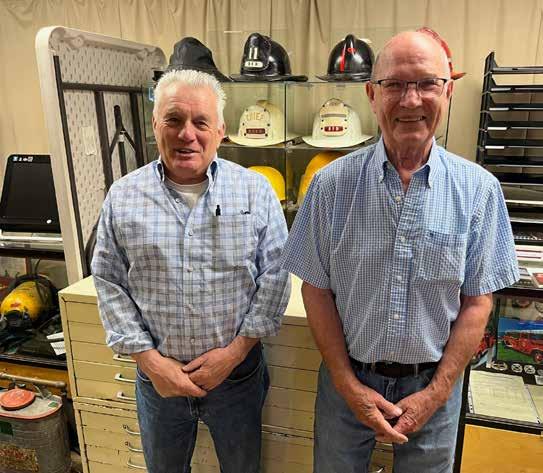
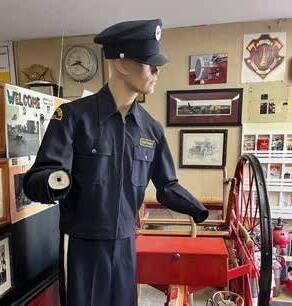
The Captain’s uniform of the late Ray Cook, who served as a volunteer firefighter in Wilmot for 33 years.
g tion
if often ignored French connec tion.
The collection includes heritage photos, such as this of a steam pumper in New Hamburg.
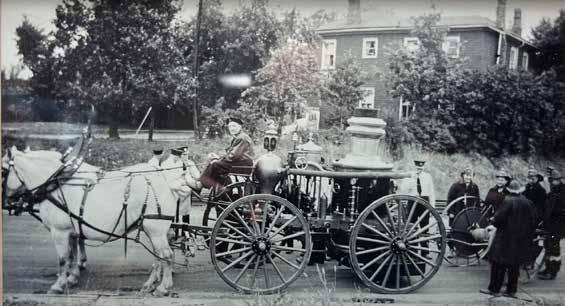
lieve there are four others, in various stages of activity. Most if not all are municipally funded. And three of them are located in communities with full-time fire departments, while the Wilmot Brigades represents the crucial, small-community service provided by volunteer fire departments.
The offer to send a delegation to Alsace was unexpected, but there was no denying the historical connections between Alsace and Wilmot township, and Mayor Myers decided not to close the door on the idea
The offer to send a delegation to Alsace was unexpected, but there was no denying the historical connections between Alsace and Wilmot township, and Mayor Myers decided not to close the door on the idea.
And speaking of volunteers – I asked the two men how many volunteer hours go into their museum each month. They mused that it must be “over 100 hours,” but then started to do the math. In reality, the active members contribute way over 200 volunteer hours a month, organizing the collection, repairing and restoring, hosting the public, and occasionally taking a truck or two to events like Canada Day in New Hamburg.
This photo includes Andr office), Michell Spetz (rig
This photo includes And office), Michell Spetz (rig
And that led, in short order, to a 1991 visit to Alsace by a delegation of 17 representatives o Wilmot and Waterloo Region; an official return visit t Wilmot in 1992 by 36 folks from Alsace; exchange program between an Alsatian high school and Waterloo-Oxford Di trict Secondary School; and some other informal conne
And that led, in short order, to a 1991 visit to Alsace by a delegation of 17 representatives Wilmot and Waterloo Region; an official return visit Wilmot in 1992 by 36 folks from Alsace; exchange program between an Alsatian high school and Waterloo-Oxford Di trict Secondary School; and some other informal conne
A tour of the museum is both fascinating and frustrating. Fascinating, because these volunteers have assembled a truly impressive collection of fire-fighting memorabilia. Frustrating, both for visitor and guide, because there simply is not room to probably display the equipment. One aisle in their building contains a complicated combination of several horse-drawn hose reels and more, all pushed together simply to keep them indoors, out of the elements.



ServingNewHamburg&Area for25 years! From our family to yours.



The volunteers are entirely committed to their mission. They have obvious, deep affection for the equipment and for the history of firefighting – after all, the majority of the volunteers were volunteer firefighters, themselves.
Locatedintheheartof NewHamburg,ourbusinessoffers atruefamilyrestaurantexperience, withitsrelaxedcountryatmosphere andtraditionalhomecookedmenu.
But the need is clear. Peter says, “We need larger facilities to display, repair and maintain everything we’ve got.”
Locatedintheheartof NewHamburg,ourbusinessoffers atruefamilyrestaurantexperience, withitsrelaxedcountryatmosphere andtraditionalhomecookedmenu. NewlyRenovated
NewlyRenovated
If not, an important opportunity to celebrate local heritage, educate, and entertain visitors will be wasted.


105PeelSt.,NewHamburg 519.662.4545
105PeelSt.,NewHamburg 519.662.4545



In pristine condition: a Fargo fire truck, one of six trucks owned by the Brigades.




The capstone says it all: “Baden Hotel. Christoph Kraus. July 22, 1874:”
To call the Baden Hotel “venerable” would be an understatement. This historic hostelry has stood at the corner of Snyder’s and Mill in Baden for a century and a half. It opened three years before James Livingston built Castle Kilbride. According to the website, “Canada’s Historic Places,” it is “one of the oldest operating taverns in Canada.”
Today, owner Abhay Patel says that although there have been brief breaks in its history, “From what I know, it has been consistently open as a hotel” since its founding. And Abhay, who bought the place in June, 2016, has invested a lot to make sure that historic line remains unbroken. An extensive renovation program, still underway on the upper floors of the building, has ensured that the building is structurally sound, historically authentic, and ready for the next century.
The renovations had to go a lot farther than Abhay had originally envisioned, because engineering reports indicated that it was necessary to build a new, steel structure inside the old brick façade. The bar and dining rooms are now beautifully finished, but a tour of what will be five apartments on the second and third floors reveal that construction has taken everything right back to the brick walls, with steel infrastructure now securing the structure.
Elements of the building hold a heritage designation, and Abhay has honoured that. The most famous features would be the 26 hand-painted scenes on the ceiling of the bar, painted by an unknown artist, perhaps in the earliest days of the hotel, certainly no later than the very early 20th century. The renovations have actually made them more accessible to visitors – they were once over the crowded bar, but Abhay has moved the bar to the centre of the building, and the paintings are now clearly visible above dining tables.
The sign on the outside of the building now reads “Baden Hotel,” although through the last four owners, it has been known as “E.J.’s at Baden.” Abhay has honoured its longer history by return-
Baden Hotel owner Abhay Patel, beside a reproduction of a sign from earlier days of the establishment. (Paul Knowles photo)



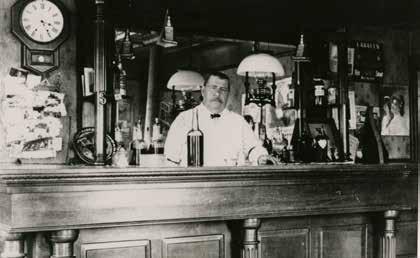
ing to the original name, but the restaurant inside is still branded as E.Js at the Baden Hotel.
Abhay is actually a pharmacist, and owner of five pharmacies, including the Pharmasaves in New Hamburg and Baden. So I asked him, “Why buy a bar?”
“I have always wanted to own a bar,” he says, “And I really like old buildings.” In the process of acquiring the local pharmacies, Abhay held business meetings at the Baden Hotel… and the rest is a continuation of a very long history.
The renovations to the main floor were completed in 2022, and Abhay says the changes – including windows that now let a lot of light into the place – have attracted a lot of new customers, as well as folks who had not dropped by for decades. It’s a busy place, with a staff of 24 full- and part-time employees.
But it’s clear that the Baden Hotel has been a busy place from the beginning. One report suggests that Kraus, the original owner, built a frame hotel in 1858, replacing it with the current building in 1874.
What is clear is that the hotel was built because the Grand Trunk Railway had laid tracks through Baden, and there was a train station near the hotel. The GTR was built through Baden and New Hamburg in 1856 (incidentally, halting the growth of nearby Haysville, which had been a stagecoach route hub on the Huron Road).
Abhay says there were once stables at the hotel, and he has heard stories of people arriving on horseback, or with horse and wagon, stabling the animals, and then boarding the train. The upper floors were then a working hotel, renting rooms; when the reno-

The hotel in the first half of the 20th century.
(Copyright Castle Kilbride)
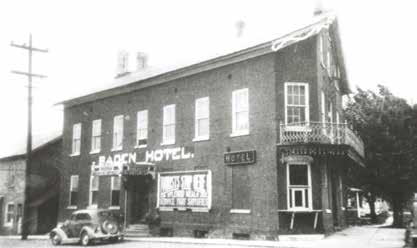
vations are completed, they will be apartments. The spacious third floor apartment occupies the space that was once the hostel, where guests simply rented bed space in an open room.
Not only was the hotel a hub for train travellers; it became the social centre of Baden for many years, and that history is reflected today in the regularly scheduled musical entertainment at the hotel.
Abhay admits that the renovation project has brought “a lot of big surprises,” many of them with unexpected costs. But he is committed to the place. “I’m not going to flip it,” he says. He’s in for the long haul.
It seemed sensible to ask this tavern-keeper about his own favourite drinks. In the winter, he admitted, “I like my Scotches.” In the warmer months, “beers and rum.”
It’s a reasonable guess that he may crack a beer as the Baden Hotel officially celebrates its 150th birthday two days early, on Saturday, July 20, 2024. Abhay plans to close down the parking lot to make room for bands and other entertainment; he’s arranging for parking areas nearby. The glitch is, Snyder’s Road, in front of the hotel, will again be closed for construction, but Abhay notes that there are other ways to get to his hotel.

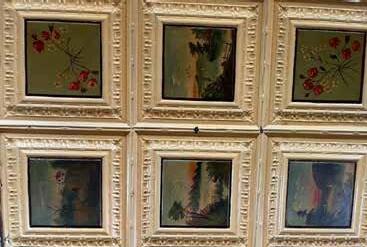
In fact, historically in Baden, all roads seem to lead to the Baden Hotel. Onsite: 177 Jacob Street, New Hamburg, ON Online: www.nhcconline.ca
Six of the famous, mysterious ceiling paintings. (Paul Knowles



